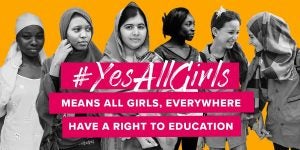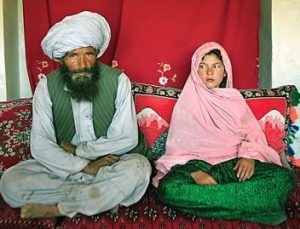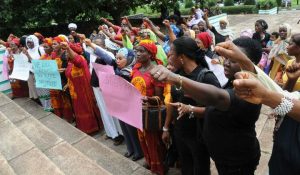By Taylor Smith
Many women all over the world value education above all else, but they are denied the opportunity to attend school.. A girl named Faith from Maasai Mara, Kenya, wanted an education, but when she turned 13, her father decided that it was time for her to marry and that she needed to stay home. He even doubled her chores so that she would not have time to study during the day. Faith did not give up and worked through all hours of the night completing her chores so that she could study during the day. Faith applied to a secondary school called Kisaruni. Unfortunately, she was unable to get in because her grades were not good enough. She went into a deep depression and her father hated to see her like that. He knew that she could have gotten into the school if she had more support and time to study. He had a change of heart and Faith was able to study and bring up her grades which eventually lead to her acceptance. Faith later went on to graduate because she never gave up fighting for her right to an education. If Faith had not fought for herself, she would have been married at 13 and would have had to rely on her husband for support. Now since Faith graduated, she can go on to have a job, gain independence for herself, and have control over her own life.
In 2019, 9 million girls at the primary age level were not in school, compared to the 3 million boys. But why is that? One reason is early childhood marriage. There are many cultural and religious reasons why childhood marriage is practiced today. One major reason is poverty. Parents can sell a child into marriage to settle debts or gain income for the in-laws although doing this puts the child at risk of never gaining an education and not being able to get a proper job to make a steady source of income. So, because of childhood marriage there is also a cycle of poverty that will not be broken unless something changes.
One other reason for girls not attending school is child labor. Sometimes parents might need children to help around the house in order to provide for them. Lots of times this work is seen as women’s work and the parents keep the daughter home over the son because a male’s education is seen as having more value than a female. So, the daughter stays home and helps with chores while sons go to school.
Another reason why girls are not going to school is pregnancy. The school may have rules restricting pregnant girls from attending, sometimes girls may not go because of embarrassment or stigma facing them. According to the World Health Organization one million girls under the age of 15 and 16 million girls from ages 15-19 are pregnant. Having to look after a baby is a full-time job so going to school or even classes can be impossible for them.
Yet it is well documented by economists and social scientists that educating girls leads to major benefits for society. The health and safety of these girls is increased with education. Women who are not educated are less likely to seek out medical help for themselves and their families. Mothers who are educated are also more likely to get their children immunized. Educating women on sexual health is also a huge benefit. Having the knowledge to prevent sexual diseases and pregnancy give women a huge advantage in gaining autonomy for themselves. Learning about different contraceptive methods allows women to see which ones work for their body and lifestyle. This also gives women a safe place to ask questions about sexual health. With parents or relatives there might be a fear or certain rules that stops girls asking those sorts of questions. Having a safe place to learn about such important information is crucial for girls to maintain a healthy lifestyle.
Women who go to school are more likely to have successful careers. That means that women can afford places to live, provide for themselves and their families, and can save for the future. More women having jobs and making money means more people spending money. More spending means more money going back into the economy. Women who make money will also have more confidence and will be willing to speak up more. This will allow more women to be in a leadership role in their everyday lives. Companies also tend to have better results when there is diversity. Hearing different opinions from different voices makes sure that all ideas are thought about and reviewed. In companies with some leadership roles filled with women the results for that company are better.
The biggest challenge that people have to overcome in order to fix the lack of women’s education is the stigma that women do not deserve to be educated. For centuries men have been seen as the “better” gender. It’s almost as if women are a subsection of humans instead of just seen as human. The best way to battle that mindset is get people all over the world educated on the different benefits that come from treating women the way they should, which is equal. To do that there needs to be funding to women’s programs of all kinds, but most importantly funding for women’s education. Education can and should give women all over the world the necessary skills for them to be the best versions of themselves.
What’s something that we can do to help this issue? The Malala Fund is an organization that is fighting for women’s education all over the world. The Malala Fund does this by investing in local education advocates, by advocating to hold leaders accountable, and by making sure women’s voices are heard. Investing in local advocates the Malala fund is making sure the people who best know these girls are getting the funding they need in order really make change happen. Holding leaders accountable is crucial because laws can be placed but that doesn’t mean that these laws are being enforced. Making sure women’s voices are heard is a great way to make sure people know the types of issues that women are facing when it comes to their education, what is causing the issues, and what can be done to fix them. To know more about the Malala Fund

visit https://malala.org/
Taylor Smith is a senior at East Carolina University who is set to graduate May 2020 with a BS in Communication. She plans to work at The Center for Leadership in Cary, NC, and to further her education in Communication.


 e left them incontinent and shunned by their husbands and the communities in which they live. Why is obstetric fistula known as the silent epidemic and why does it disproportionately effect women in the developing world? Why do some of the women in this film say that death would be preferable to living with fistula? If you were tasked with doing something to help prevent this problem in countries like Ethiopia, what would you do–where would you begin and why?
e left them incontinent and shunned by their husbands and the communities in which they live. Why is obstetric fistula known as the silent epidemic and why does it disproportionately effect women in the developing world? Why do some of the women in this film say that death would be preferable to living with fistula? If you were tasked with doing something to help prevent this problem in countries like Ethiopia, what would you do–where would you begin and why? from a murder charge when she killed the rapist who abducted her. The film brings to light the ongoing issue of child marriage in many parts of the world. This custom of abduction of young girls disrupts their education and chances for a better life, leading to early pregnancies, poor health outcomes and continuing poverty for them and their children.
from a murder charge when she killed the rapist who abducted her. The film brings to light the ongoing issue of child marriage in many parts of the world. This custom of abduction of young girls disrupts their education and chances for a better life, leading to early pregnancies, poor health outcomes and continuing poverty for them and their children.
 Leangei Gomez Nuñez
Leangei Gomez Nuñez